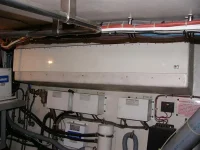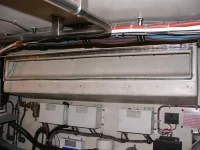If your 77 has the same open rectangular engine vents as ours we have something that works well. I cut blocks of 4" foam rubber to be slightly larger than the vent openings (+ 1/4 - 1/2 inch bigger) Bought some "oil cloth" (cloth backed plastic you see on table tops sometimes - pacific blue like our canvas) at a fabric/sewing shop and covered the foam pieces (two ends, and piece wrapped around to have just one side seem - Sew inside out, pull rightside out - stuff foam and hand sew the open area you leave on the middle of the one side seem, 12 -18" or big enough to stuff the foam). You could use that thin blue tarp material or something similar also. Anyway, we have a soft, wind proof "plug" about 3 1/2 feet by 6 " x 4" that I can just slide/press into the vent opening and/or remove in seconds. Air tight, prettty good R value, easy, light weight and cheap. Works great if you have the "open" style vents. No suggestions for the louvered type. Made similar "soft plugs" for all the smaller vent openings. Seals/removes from entire hull in under a minute. Have lasted for almost 10 years so far.
Regards, Bob K



